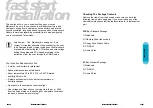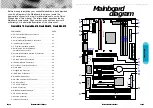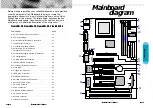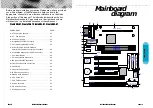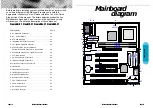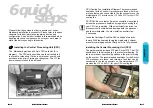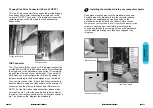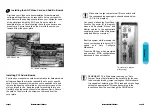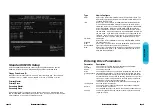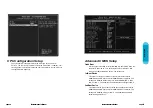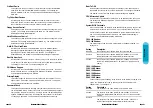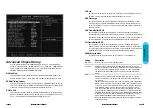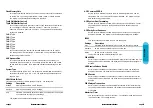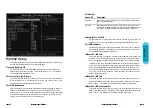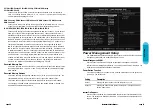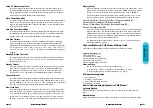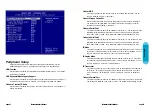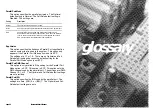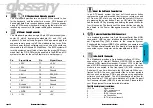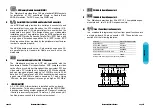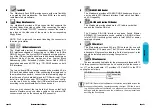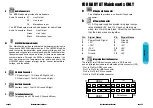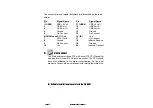
Mainboard User's Manual
Page 35
Page 34
Mainboard User's Manual
AGP Common SERR#
Set this option to Enabled to permit a common SERR# signal for AGP and the
standard PC bus. The settings are Enabled or Disabled. The Optimal and Fail-
Safe default settings are Enabled.
AGP System Error Forwarding
Set this option to Enabled to enable AGP system errors to be forwarded. The set-
tings are Enabled or Disabled. the Optimal and Fail-Safe default settings are
Enabled.
AGP Parity Error Response
Set this option to Enabled to enable AGP parity error response. The settings are
Enabled or Disabled. The Optimal and Fail-Safe default settings are Enabled.
IRQ12
This option specifies how IRQ12 is used. The settings are:
The Optimal and Fail-Safe default settings are Auto.
PIIX4 SERR#
Set this option to Enabled to enable the SERR# signal for the Intel PIIX4 chip. The
settings are Enabled or Disabled. The Optimal and Fail-Safe default settings are
Disabled.
USB Passive Release Enable
Set this option to Enabled to enable passive release for USB. The settings are
Enabled or Disabled. The Optimal and Fail-Safe default settings are Disabled.
PIIX4 Passive
Set this option to Enabled to enable passive release for the Intel PIIX4 chip. the
settings are Enabled or Disabled. The Optimal and Fail-Safe default settings are
Enabled.
PIIX4 Delayed Transaction
Set this option to Enabled to enable delayed transactions for the Intel PIIX4 chip.
The settings are Enabled or Disabled. The Optimal and Fail-Safe default settings
are Enabled.
Master Lat. Timer
This option specifies the latency for the Timer. The settings are 00h through F8h in
increments of 08h. The settings are 00h.
Fixed Memory Hole
This option specifies the location of an area of memory that cannot be addressed
on the ISA bus. The settings are Disabled, 15 MB -16 MB, or 512KB - 640 KB.
The Optimal and Fail-Safe default settings are Disabled.
TypeF DMA Buffer Control1
TypeF DMA Buffer Control2
These options specify the DMA channel where TypeF buffer control is implement-
ed. the settings are Disable, Channel-0, Channel-1, Channel-2, Channel-3,
Channel-4, Channel-5, Channel-6, Channel-7. The Optimal and Fail-Safe default
settings are Disabled.
DMA-0 Type
DMA-1 Type
DMA-2 Type
DMA-3 Type
DMA-5 Type
DMA-6 Type
DMA-7 Type
These options specify the bus that the specified DMA channel can be used on.
The settings are PC/PCI, Distributed, or Normal ISA. The Optimal and Fail-Safe
default settings are Normal ISA.
AGP Aperture Size
This option specifies the amount of system memory that can be used by the
Accelerated Graphics Port (AGP). The settings are 4 MB, 8 MB, 16 MB, 32 MB,
64 MB, 128 MB, or 256 MB. The Optimal and Fail-Safe default settings are 256
MB.
System Type
This option sets the system type. The settings are Auto (AMIBIOS automatically
determines the system type). DP, or UP. The Optimal and Fail-Safe default set-
tings are Auto.
USWC Write I/O Post
This option sets the status of USWC posted write to I/O. The settings are:
Settings
Enabled
Disabled
Auto
Description
USWC posted writes to I/O are enabled.
USWC posted writes to I/O are disabled.
AMIBIOS automatically determines if USWC posted writes to I/O should
be enabled and sets this option accordingly.
The Optimal and Fail-Safe default settings are Auto.
Settings
Auto
Standard
Mouse
Description
AMIBIOS automatically determines how IRQ12 should be allocated.
IRQ12 is made available for use on the ISA bus.
IRQ12 is used by the PS/2 mouse.

